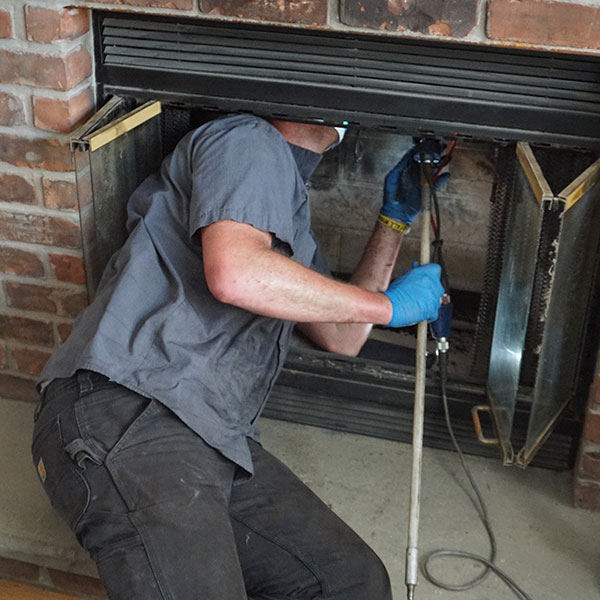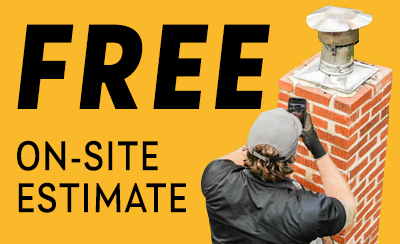We are a qualified chimney cleaning company with the Chimney Safety Institute of America and the National Fireplace Institute. Our technicians will perform a thorough sweep and inspection of your fireplace and chimney.
 Our Process
Our Process
- We will arrive at your property and set up a clean work space
- We will sweep your chimney from the inside
- We will perform a camera inspection to examine the interior of your chimney and fireplace
- If the roof is accessible, we will inspect the exterior of your chimney
- We will give you an inspection report
- If we notice anything that needs to be repaired, we will give you an estimate for the repairs
Call us today to schedule your sweep and inspection for $199!
Why Should You Sweep Your Chimney?
According to the Chimney Safety Institute of America, below are some facts about your chimney.
Your chimney–and the flue that lines it–adds architectural interest to your home, but its’ real function is to carry dangerous flue gases from your fireplace, wood stove or furnace safely out of your home.
As you relax in front of your fireplace or bask in the warmth of your wood stove, the last thing you are likely to be thinking about is the condition of your chimney. However, if you don’t give some thought to it before you light those winter fires, your enjoyment may be very short-lived.
Why?
Dirty chimneys can cause chimney fires, which damage structures, destroy homes and injure or kill people.
Indications of a chimney fire have been described as creating:
- loud cracking and popping noise
- a lot of dense smoke, and
- an intense, hot smell
Chimney fires can burn explosively – noisy and dramatic enough to be detected by neighbors or people passing by. Flames or dense smoke may shoot from the top of the chimney. Homeowners report being startled by a low rumbling sound that reminds them of a freight train or a low flying airplane. However, those are only the chimney fires you know about.
The Majority of Chimney Fires Go Undetected
Slow-burning chimney fires don’t get enough air or have fuel to be dramatic or visible and they often go undetected until a later chimney inspection, but, the temperatures they reach are very high and can cause as much damage to the chimney structure – and nearby combustible parts of the house – as their more spectacular cousins.

Creosote & Chimney Fires: What You Must Know
Fireplaces and wood stoves are designed to safely contain wood-fuel fires, while providing heat for a home. The chimneys that serve them have the job of expelling the by-products of combustion – the substances produced when wood burns. These include smoke, water vapor, gases, unburned wood particles, hydrocarbon, tar fog and assorted minerals. As these substances exit the fireplace or wood stove, and flow up into the relatively cooler chimney, condensation occurs. The resulting residue that sticks to the inner walls of the chimney is called creosote.
Creosote is a black or brown residue that can be crusty and flaky…tar-like, drippy and sticky…or shiny and hardened. All forms are highly combustible. If it builds up in sufficient quantities – and the internal flue temperature is high enough – the result could be a chimney fire.
Conditions that encourage the buildup of creosote:
- restricted air supply
- unseasoned wood
- cooler than normal chimney temperatures
Air supply may be restricted by closing the glass doors, by failing to open the damper wide enough, and the lack of sufficient make-up air to move heated smoke up the chimney rapidly (the longer the smoke’s “residence time” in the flue, the more likely is it that creosote will form). A wood stove’s air supply can be limited by closing down the stove damper or air inlets too soon or too much. Burning unseasoned wood – because so much energy is used initially just to drive off the water trapped in the cells of the logs– keeps the resulting smoke cooler, than if seasoned wood is used. In the case of wood stoves, overloading the firebox with wood in an attempt to get a longer burn time also contributes to creosote buildup.
The Effect of a Chimney Fire on Your Chimney
Masonry Chimneys
When a chimney fire occurs in a masonry chimney – whether the flue is an older, unlined type or tile lined to meet current safety codes – the high temperatures at which they burn (around 2000°F) can “melt mortar, crack tiles, cause liners to collapse and damage the outer masonry material”. Most often, thermal shock occurs and tiles crack and mortar is displaced, which provides a pathway for flames to reach the combustible wood frame of the house. This event is extremely dangerous, call 911 immediately.
Prefabricated, factory-built, metal chimneys
To be installed in most jurisdictions in the United States, factory built, metal chimneys that are designed to vent wood burning stoves or prefabricated metal fireplaces must pass special tests. Most tests require the chimney to withstand flue temperatures up to 2100°F – without sustaining damage. Under chimney fire conditions, damage to these systems still may occur. When prefabricated, factory-built metal chimneys are damaged by a chimney fire, they should no longer be used and must be replaced.
Special Effects on Wood Stoves
Wood stoves are made to contain hot fires. The connector pipes that run from the stove to the chimney are another matter. They cannot withstand the high temperatures produced during a chimney fire and can warp, buckle and even separate from the vibrations created by air turbulence during a fire. If damaged by a chimney fire, they must be replaced.
Nine Signs that You’ve Had a Chimney Fire
Since a chimney, damaged by a chimney fire, can endanger a home and its’ occupants and a chimney fire can occur without anyone being aware of them it’s important to have your chimney regularly inspected by a CSIA Certified Chimney Sweep. Here are the signs that a professional chimney sweep looks for:
- “Puffy” or “honey combed” creosote
- Warped metal of the damper, metal smoke chamber connector pipe or factory-built metal chimney
- Cracked or collapsed flue tiles, or tiles with large chunks missing
- Discolored and/or distorted rain cap
- Heat-damaged TV antenna attached to the chimney
- Creosote flakes and pieces found on the roof or ground
- Roofing material damaged from hot creosote
- Cracks in exterior masonry
- Evidence of smoke escaping through mortar joints of masonry or tile liners
If you think a chimney fire has occurred, call a CSIA Certified Chimney Sweep for a professional evaluation. If your suspicions are confirmed, a certified sweep will be able to make recommendations about how to bring the system back into compliance with safety standards. Depending on the situation, you might need a few flue tiles replaced, a new liner system installed or an entire chimney rebuilt. Each situation is unique and will dictate its own solution.
Proper Maintenance
Clean chimneys don’t catch fire. Make sure a CSIA Certified Chimney Sweep® inspects your solid fuel venting system annually, and sweeps and repairs it whenever needed. Your sweep may have other maintenance recommendations depending on how you use your fireplace or stove. CSIA recommends that you call on CSIA Certified Chimney Sweeps®, since they are regularly tested on their understanding of the complexities of chimney and venting systems.




